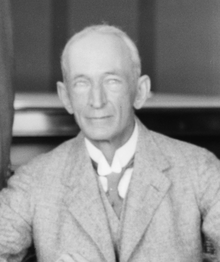Walter Shaw (judge)
Sir Walter Sidney Shaw (15 April 1863 – 24 April 1937) was an English lawyer and judge in the early 20th century. He served as a judge in a number of British colonies, his last judicial appointment being the Chief Justice of the Straits Settlements. He was also the chairman of the Shaw Commission which investigated the 1929 Palestine riots.[3]
Sir Walter Sidney Shaw | |
|---|---|
 | |
| Born | 15 April 1863[1] Marylebone, London |
| Died | 24 April 1937 (aged 74)[2] |
| Nationality | British |
| Alma mater | Trinity College, Cambridge |
| Occupation | Judge |
| Spouse(s) | Dorothy Emma Mortimore ( m. 1895) |
Early life and marriage
Shaw, born in 1863, was the son of George Shaw, a barrister. He was educated at Brighton School and Trinity College, Cambridge.[4] He was called to the Bar at the Middle Temple in 1888, and practiced at common law until 1906.[5]
Shaw married Dorothy Emma Mortimore, daughter of Foster Mortimore, in 1895. They had a son and a daughter.[4]
Legal appointments
In 1906, Shaw was appointed Police Magistrate and Acting Chief Justice of St Vincent. He became Chief Justice in 1907 and was appointed to the Executive and Legislative Councils.
From 1912 to 1914 he was Chief Justice of British Honduras (now Belize) and between 1914 and 1921 served as a puisne judge of the Supreme Court of Ceylon. He was knighted in the 1921 Birthday Honours.[4][6]
He was appointed as Chief Justice of the Straits Settlements in 1921 and served in that position until his retirement in 1925.[7]
When Shaw came to Singapore he introduced the custom of wearing a wig in court. Upon his retirement, he explained that it was "not because I have any desire to attire myself in fancy costume, or because I wished to give myself any special personal importance, but because I think that it tends to remind, not only the public and the Bar, but even the judge himself, that he is a representative of that very illustrious body of men – the English judges, who have done so much to establish and maintain the freedom of the English people".[8]
Shaw Commission

In 1929, Shaw chaired the Commission on the Palestine Disturbances of August 1929, commonly known as the Shaw Commission, which looked into the causes of the 1929 Palestine riots.[9] The Shaw Commission found that the fundamental cause of the violence "without which in our opinion disturbances either would not occurred or would not have been little more than a local riot, is the Arab feeling of animosity and hostility towards the Jews consequent upon the disappointment of their political and national aspirations and fear for their economic future".[10]
Legacy
Shaw Road in Singapore was either named after Shaw or a Mr. Shaw, a partner in Shaw, Whitehead and Company.[11]
References
- Dod's Peerage, Baronetage and Knightage, of Great Britain and Ireland. S. Low, Marston & Company. 1923. p. 284. Retrieved 11 July 2017.
- England & Wales, National Probate Calendar (Index of Wills and Administrations), 1858-1966, 1973-1995
- "Sir Walter Shaw – A Distinguished Colonial Judge". The Times. The Times Digital Archive. 24 April 1937. p. 16.
- Kingston Gleaner, 26 May 1937.
- The Straits Times (Singapore), 4 September 1929, p. 12.
- "No. 13745". The Edinburgh Gazette. 23 September 1921. p. 1568.
- The Straits Times (Singapore), 8 April 1925, p. 8.
- "Sir Walter Shaw: Bar's tributes to retiring Chief Justice", The Straits Times, p. 11, 9 April 1925; "Judge who introduced full bottomed wig to Malaya: Sir Walter Shaw's fine career recalled", The Straits Times, p. 12, 26 April 1937.
- The Commission's report was published as Report of the Commission on the Palestine Disturbances of August, 1929 [Chairman: Sir Walter Shaw; Cmnd. 3530], London: His Majesty's Stationery Office, 1930, OCLC 65429496. For discussion and criticism, see Horace Barnett Samuel (1930), Beneath the Whitewash: A Critical Analysis of the Report of the Commission on the Palestine Disturbances of August, 1929, [London]: Hogarth Press, OCLC 4134491; Pinhas Ofer (July 1985), "The Commission on the Palestine Disturbances of August 1929: Appointment, Terms of Reference, Procedure and Report", Middle Eastern Studies, 21 (3): 349–361, doi:10.1080/00263208508700633.
- Shaw Report, pp. 150–157.
- Victor R. Savage; Brenda S. A. Yeoh (2013), Singapore Street Names: A Study of Toponymics, Singapore: Marshall Cavendish, p. 344, ISBN 978-981-448474-9.